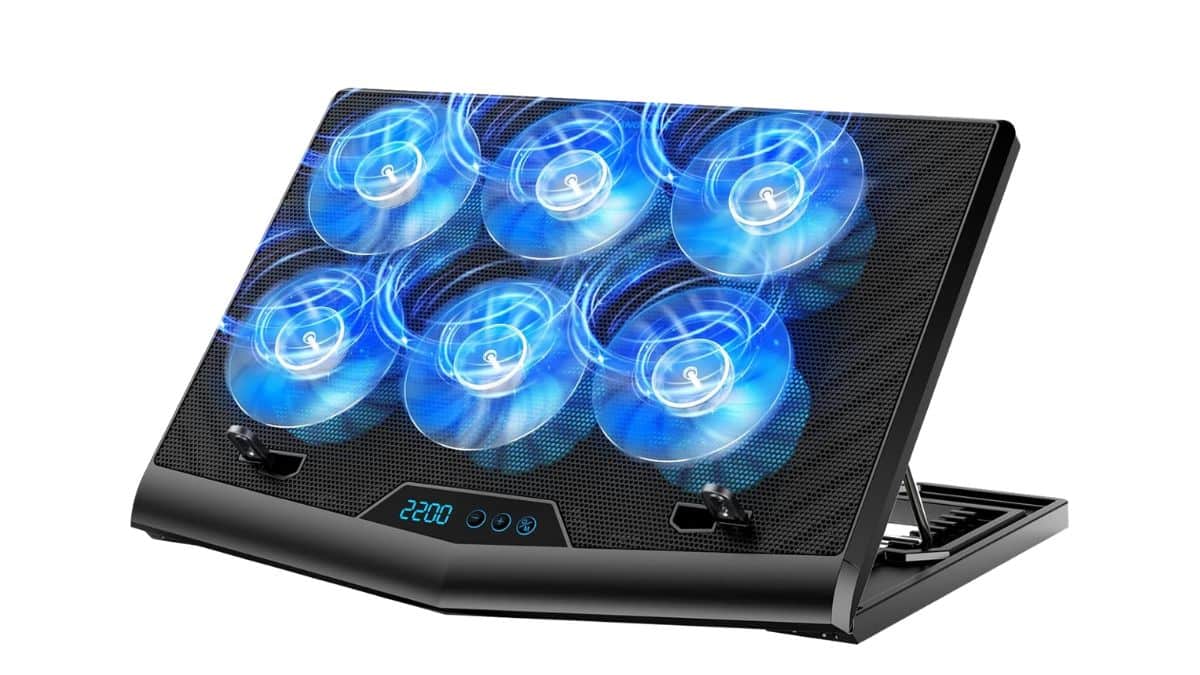HIGHLIGHTS
- Introduction about the laptop cooling pads.
- How does a laptop cooling pad work and why do you need one?
- Benefits and features of laptop cooling pad.
 The fact that over 60% of laptops run at high temperatures, which reduces performance or even breaks the hardware entirely, is well known to laptop users.This guide will provide you with an insight into the need to regulate the temperatures of the laptops and how a cooling pad will be of enormous assistance. Let us review the general operation of these devices, their advantages, and some important points that should not be overlooked as you make your choice. At the end of using this guide, the user will be able to grasp full knowledge of laptop cooling pads and the importance of using them on a laptop.
The fact that over 60% of laptops run at high temperatures, which reduces performance or even breaks the hardware entirely, is well known to laptop users.This guide will provide you with an insight into the need to regulate the temperatures of the laptops and how a cooling pad will be of enormous assistance. Let us review the general operation of these devices, their advantages, and some important points that should not be overlooked as you make your choice. At the end of using this guide, the user will be able to grasp full knowledge of laptop cooling pads and the importance of using them on a laptop.
Table of Contents
What is a Laptop Cooling Pad?
Definition
A laptop cooling pad therefore is a device that is especially used to cool a laptop during operations. It protects from overheating which causes hardware failure, low efficiency, and shortening of the utilization of the device. Thus, cooling pads are most effective during heavy work, for example, when playing games, editing videos, or using two or more programs at once.
Components
Fans:
The central part of a cooling pad is the fan since it is involved in the process of removing heat from the laptop. Fans may be one or several and of different sizes and rotate at different speeds thus affecting the cooling effect. Some pads allow the users to set various fan speeds for their desired level of cooling.
Surface Material:
The exterior side of a cooling pad can be metallic, plastic, or meshwork depending on the manufacturer’s intended design. Metallic areas are desirable, specifically utilizing aluminum, for elements such as solution heat sinks. The outer skin of the baz is normally designed to include various holes for the air to pass through.
USB Ports:
Some cooler pads are connected with a cable that draws its power from the laptop’s USB port. Some pads have extra USB sockets for connection of other accessories such as a mouse, keyboard, or any other external hard drives.
Types of Cooling Pads
Active Cooling Pads:
These pads employ special fans that blow air and cool the laptop in an avoidable fashion. These are the volatile ones, and they are quite efficient in lowering temperatures in the property.
Passive Cooling Pads:
These don’t use fans yet they employ the use of material that has high heat dissipation features, for instance, metal or gel. They are relatively low-profile products but they are less efficient than active cooling pads.
Hybrid Cooling Pads:
Certain cooling pads use both active and passive systems, where the use of fans is incorporated along with heat-reducing materials to further push the cooling process.
How Does a Laptop Cooling Pad Work?
Mechanism:
A laptop cooling pad may be just as important as the battery; the device’s main job in keeping a laptop cooler during operation is to release any heat that is generated or passes through an appropriate channel. It cools the peripheral area of the laptop from generating heat which is very crucial for the functionality of the laptop.
Active Cooling Pads
- Fans and Airflow: Intensive cooling pads utilize internal fans; therefore, they suck cool air from the surroundings and blow it over the base of the laptop overheating heat vents. It also helps with the airflow arrangement of the computer to cool hot items like the CPU and the GPU.
- Power Source (USB-powered): These cooling pads get their electricity through USB ports and may include other USB ports for the other packages.
Passive Cooling Pads
- Heat Dissipation Materials: They are cooling pads that have no fan and only depend on the material that has a high thermostat such as metals to cool the pads. Some models are fitted with a gel or a crystal that is cool for this purpose, rather than spreading heat over a larger area.
- Ergonomic Design: Typically, these pads are slim and properly ergonomic, which helps to elevate a laptop and enhances airflow, as well as making typing and viewing more comfortable and reducing wrist and neck strain.
Benefits of Using a Laptop Cooling Pad
The advantages of using a laptop cooling pad are numerous and may be divided into three primary categories: effectiveness, durability, reduced wear, and comfort, along with additional qualities. Here’s a breakdown of these benefits:
Enhanced Performance
- Prevents Overheating: With the help of these cooling pads, heat dissipation is improved and overheating incidents on these laptops are reduced, particularly when prolonged or intensive graphical activities are performed.
- Maintains Optimal Speed and Efficiency: Cooling pads, therefore, play a role in avoiding the heating problem that interferes with the functionality of the laptop and thus retain better functionality.
Prolonged Lifespan
- Prolonged Lifespan: This in turn cools the internal cases of the laptops hence the heat damage is avoided and in extension, the life of the laptops is prolonged.
- Reduces Wear and Tear on Internal Components: Additionally, the key components of computers, such as the processors, graphics cards, and hard drives, are not subjected to significant strain at H freezing temperature over an extended period of time.
- Minimizes Risk of Hardware Failure: Maintenance lowers aspects that would contribute to issues with associated hardware like the failure in the circuits or damage of batteries.
Comfort and Ergonomics
- Improved Typing Angle: There are also cooling pads with the attaining characteristic to enable improvement of the position of typing to reduce pressure on the hands of the wrist.
- Reduced Heat Exposure to User: The cooling pad helps to lower the temperature on the outer surface of the laptop and can be friendly for use on the laps or near the skin.
Key Features to Look for in a Laptop Cooling Pad
Fan Speed and Number
Importance of Adjustable Fan Speeds:
- Customization: This allows you to adjust the amount of airflow it produces based on your needs by simply changing the fan—either inside or because of its noisy, continuous operation. This feature is very handy when there are different usage profiles for the notebook, for instance, occasional Internet surfing, or intense gaming.
- Energy Efficiency: This also allows for regulation of the fans, so in cases where you do not require much air, you can turn down the flow which increases the battery power of the cooling pad in the event it is USB-powered.
Multiple Fans for Even Cooling Distribution:
- Enhanced Cooling: Some fans ensure that fresh air is circulated all over the base of the laptop computer. This is important mainly in cooling some components like the processor, graphic card, and hard disk which are hot.
- Therefore, cooling of every sub-assembly that a system embeds is one of the critical areas of focus in the design.
- Targeted Cooling: There is a cooling pad with a built-in, fan that directs cooling air to hot areas of the laptop This makes the cooling process to be effective mostly in the areas that are affected.
Build Quality
Durable Materials (Metal vs. Plastic):
- Metal Cooling Pads: Taking an overall comparison of the other pads which are mostly of aluminum, these are not only stronger but can also pass heat easily. This way the metal surface can collect more heat and transfer it to other areas; thus, enhancing the overall cooling rates.
- Plastic Cooling Pads: Plastic cooling pads are known to be smaller in size than metal ones, yet the cooler and cheaper ones, cool less than metal ones. But they can remain operational and most of them are produced flexibly with more features like height changes or included shelves.
Non-Slip Surface for Stability:
- Secure Placement: When the laptop is placed on an uneven or sloping surface, its ability to hold its position is enhanced by having a non-slip surface. It is especially necessary for eliminating any possibility for an opportunity of a minor accident that may happen since they are damaging to the product as well as hinders its use.
- Comfort and Safety: Overall for the laptop users also the proper position of the laptop can enhance user comfort and safety specifically when typing or even during gaming.
Portability
Lightweight Design for Easy Transport:
- Convenience: For people who cool their laptop at work and then at home or school, a large cooling pad would be better suited for use at home or in the classroom. However, a lightweight cooling pad is much more portable. This portability makes sure that you are always located in a place with good cooling no matter the station you are in.
- Travel-Friendly: Furthermore, this feature is quite advantageous, particularly for individuals who travel frequently, since the cooling pad may be transported along with a laptop and other pertinent objects that are compatible with it.
Foldable or Compact Models:
Space-Saving: Sleek design models are appropriate for a user who has limited table space or one who removes the table now and then. Come in portable types that can be carried in a backpack, laptop bag, and so on making it convenient to carry the cooling pad along.
Versatility: Some of these are more portable and the additional features such as height adjustment or even a port, something like a USB port are evidence that these fans are much more than a cooling device.
Top Recommendations for Laptop Cooling Pads
Cooler Master Notepal X3
Key Features:
- Fan: 200mm large fan that is efficient in cooling the CPU according to the cooling needs.
- Adjustable Height: Owing to its ergonomic design it features various height settings.
- Extra USB Ports: Owned two USB 2. 0 pass-through ports.
- Build Quality: The surface of this product is made of a long-lasting mesh material to ensure adequate ventilation.
Pros:
- High rate of cooling due to the addition of a large fan.
- The shape and design allow for more comfortable typing.
- Additional USB ports help connect the peripherals.
Cons:
- Higher rpm on the large fan could be noisy.
- It is again rather large and could therefore not be the best when it comes to portability.
Thermaltake Massive 20 RGB
Key Features:
- Fan: RGB 200mm fan which can be customized.
- Adjustable Height: There are four positions to change the height of the Micros system for the best ergonomic position.
- Cooling Surface: It supports most of the laptops up to 19 inches.
- Design: It has a fan speed control knob.
Pros:
- RGB lighting increases appearance and creativity.
- Measurement of the amount of cool air with the help of the controlled fan speed.
- For larger laptops and built to be heavy duty.
Cons:
- Products and services are slightly more expensive than some other online retailers.
- RGB lighting might be a nuisance to some users.
Klim Wind
Key Features:
Fans: 4 fans of high performance to increase the rate of heat dissipation.
Adjustable Height: Swivel, tilt, and height adjustable stand for flexibly positioning the monitor to different angles.
Build Quality: Aluminum base for having a better lifecycle of the product.
Compatibility: Compatible with laptops of up to 17 inches.
Pros:
- Proper cooling is another feature that is enhanced by the presence of many fans.
- Lightweight and portable.
- It is relatively quiet even though it has multiple fans.
Cons:
- They may not cool as effectively as larger models of the air conditioner.
- Restricted only to notebooks up to 17 inches do not cover larger portable computers.
How to Use Your Laptop Cooling Pad Effectively
Setup Instructions
Unbox and Inspect:
- As soon as the cooling pad is opened from its packaging, you should check it to make sure there are no flaws or missing parts.
- Apart from the body, check if other parts of the printer for instance the fan and USB cables are present.
Adjust Settings:
- If the cooling pad has an adjustable height or angle, you should set it properly to have the right height and angle that you want.
- In case, the cooling pad comes with multiple fan speeds or RGB lighting set them in a position that you desire.
Placement on the Desk or the Lap
On a Desk:
- It is recommended to put the cooling pad on a flat and non-slipping platform.
- Make sure that the fans on the cooling pad are parallel to the air vent strips on the base of your laptop.
- Place the cooling pad in such a way that it does not block any air vents and it doesn’t occupy too much desk space.
On Your Lap:
- If the cooling pad is placed on the lap, then it should be balanced and comforting.
- It is suggested to use a lap desk or cushion if necessary, preferably for the larger or heavier cooling pad.
- For better heat dissipation, watch where you place it as using it on your lap may not conduct heat as when placed on a hard surface.
Connecting via USB Ports
USB Connection:
- Plug the other end of the cooling pad’s USB cable into any of the USB ports in the laptop.
- If the cooling pad has any other USB ports they are used to connect other peripherals such as a keyboard or mouse.
Power Management:
- Check to confirm that the cooling pad is on and working as it should.
- Some cooling pads come with a switch that turns them on or off; make sure the pad you are using is on if necessary.
Maintenance Tips
Cleaning Fans Regularly:
- Frequency: Clean the fans at least once a month or if the performance of the fans is reduced then one should clean it more often than once a month.
- Method: To clean it a can of compressed air is used to blow dust and other dirt that would have accumulated on the blades of the fan. Dust can also be brushed off using a facial brush for this a soft bristled brush should do.
Checking for Wear and Tear:
- Inspect Regularly: Sometimes, take a physical inspection of the cooling pad in a bid to ascertain which of the parts have become depants, which among the fans have failed, or whether any of the cables are burnt.
- Functionality Test: Examine all labeled parts ( e.g., fans, USB ports) and, if any, solve the issues for their presence.
FAQs
Do all laptops need a cooling pad?
It should be noted that not all laptops require a cooling pad. They are a lot beneficial for high-performing laptops or when the laptop is put under much stress to assist in cooling but there exist many normal-performing laptops that already have internal cooling done properly.
Can a cooling pad replace internal laptop fans?
No, a cooling pad cannot work in the place of the internal fans of the laptop. This increases the amount of cool air drawn to the laptop but does not replicate the internal cooling systems of the laptop.
How much noise do cooling pads make?
It is important to note that the noise produced by one DRO is different from the other depending on the model. Most cooling pads are relatively silent; however, those that are equipped with a high-speed fan or multiple fans make more noise.
Conclusion:
Using a laptop cooling pad is essential to ensuring improved performance and longer laptop lifespan, especially while doing strenuous tasks or in hot weather. Having extra hits per minute and assisting in the dispersion of heat, a cooling pad can avoid the occurrence of thermal throttling and continue to run efficiently. When you spend money on a good cooling pad you are spending in equipment that allows your laptop to be efficient, to have a longer life, as well as increasing your laptop experience.


